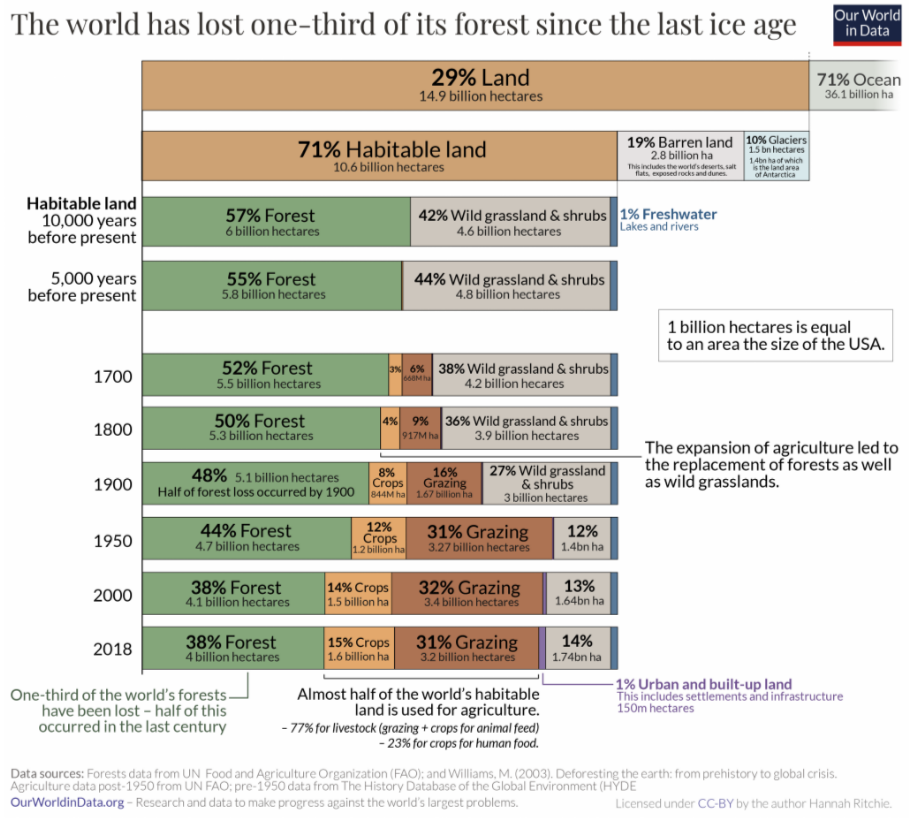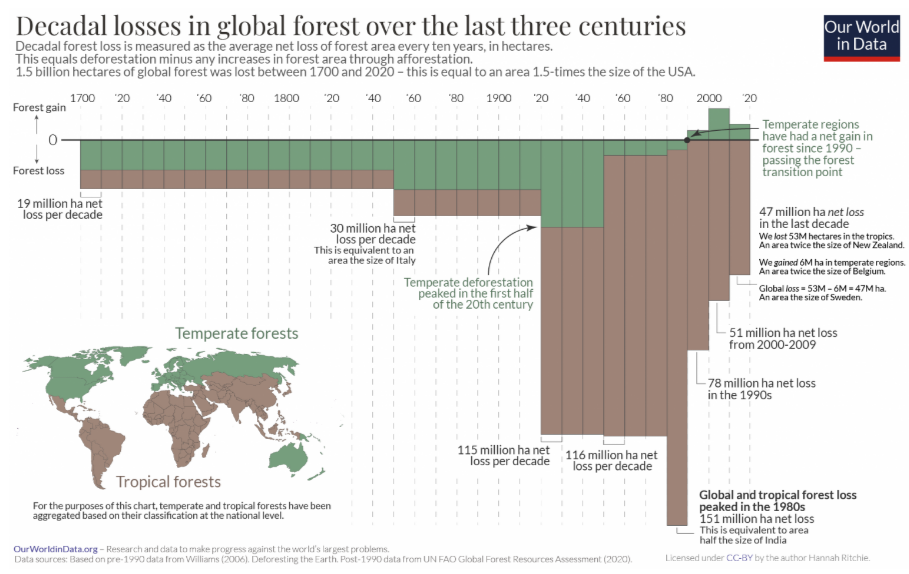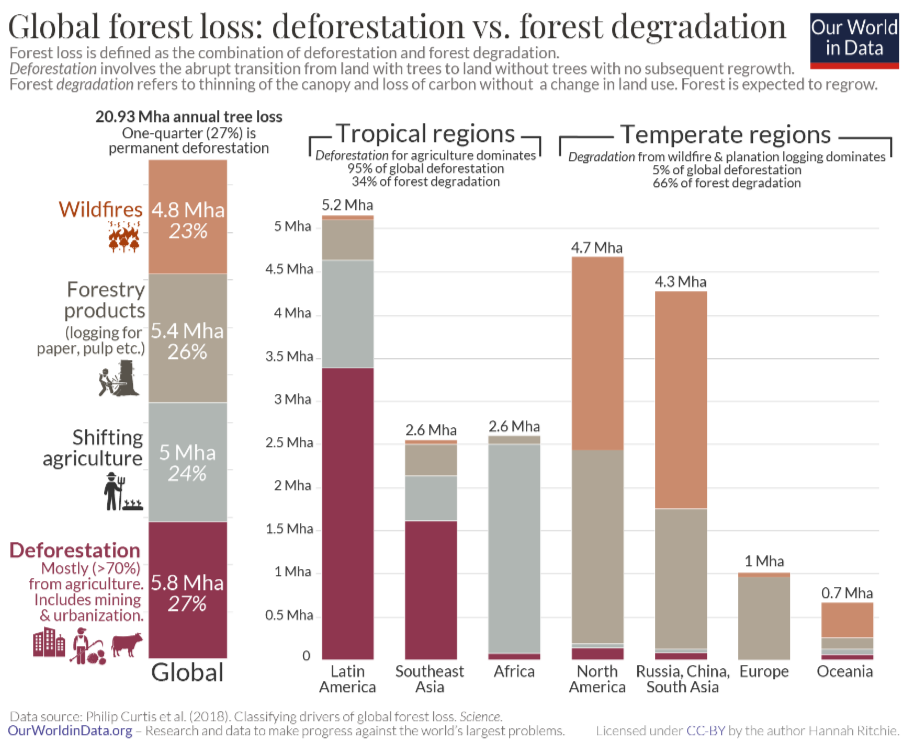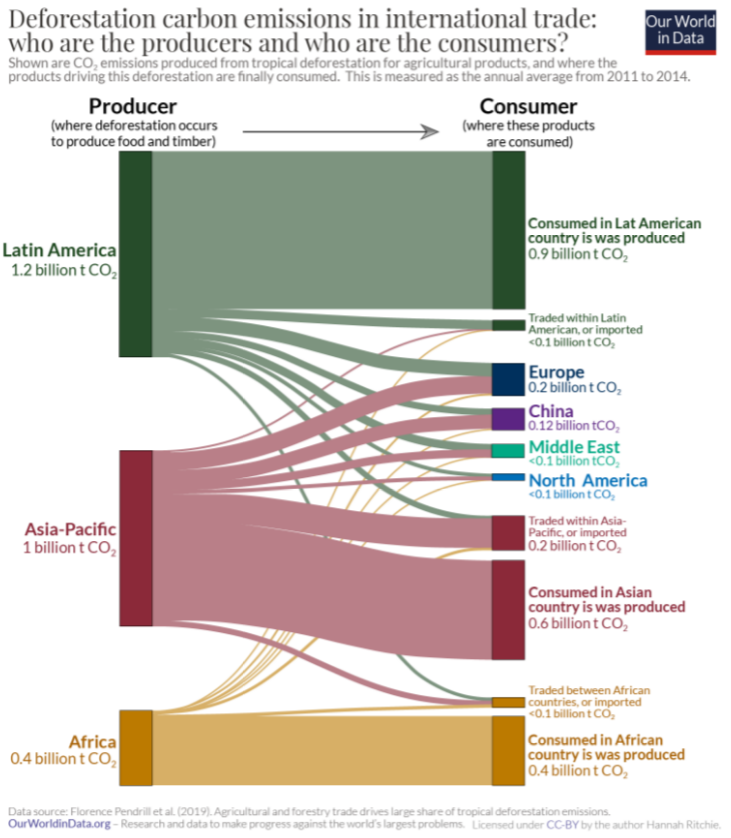Written by Ryan McGuine //
Humans have been changing the landscapes around them for millennia. Some began electively breeding crop varieties, grazing livestock, and clearing forests to do so as early as 3,000 years ago. The population was quite small then by today’s standards, but the amount of land per person required to grow enough food was quite large. While clearing forests is not a new phenomenon, and crop yields today are much higher than they once were, deforestation has still accelerated in recent decades — the world lost about as much forest in the last 100 years as it had over the previous 9,000 years.

Deforestation is a special case of forest loss, whereby the conversion of forested land to some other land use is permanent. About 10m hectares of forest is cut down globally each year, and around half of that is replanted, so most years experience 5m hectares of net forest loss. There are plenty of reasons to value nature and forests for their own right, but there are also many important reasons to do so because of what they provide humanity. For example, wild plants and animals are a crucial source of food and medicine for many. Additionally, tropical forests store a lot of carbon per unit area, and their conversion to human-controlled land is second only to fossil fuel combustion in its contribution to climate change, at about 30% of global annual carbon emissions. Slowing deforestation would help preserve resources people depend on, and reduce the likelihood of extreme weather events.
Metrics like biodiversity and carbon emissions due to deforestation are orders of magnitude larger in some geographies compared to others. In particular, the tropics contain the highest concentrations of plant and animal species on earth, and the trees there have very high levels of stored carbon. Tropical deforestation has the worst environmental impacts of any region today because the ecosystems have taken centuries to develop, and cannot easily be replaced once chopped down. Tropical regions are also where the majority of deforestation occurs today — nearly 95% of modern-day deforestation occurs in the tropics. In contrast, many original temperate forests have already been cut down, so the environmental impacts of forest loss there are much smaller.

Modern forest loss has numerous drivers, and extensive data collection by measures like satellites can give a fairly detailed idea of the relative contribution of each. The largest major driver is commodities, which refers to the large-scale, long-term conversion of forests to some other land use, and accounts for about 27% of all global deforestation. Commodity production includes commodity agriculture like clear-cutting forest for cattle grazing or row crop production. It also includes the construction of mining or energy infrastructure. Most tropical deforestation like the recent Amazon fires, fall into this category. While all drivers of forest loss reduce the ecosystems’ original biodiversity and ability to store carbon dioxide, commodity production is the only one which does so permanently. The other drivers can be thought of as “forest degradation,” because the ecosystem experiences a short-term disturbance, but will likely regrow if left alone.
The next major cause of forest loss is forestry at 26%, and counts logging for timber and paper, as well as replacing original forest with plantations of managed trees like rubber, teak, or palm oil. Forestry is most often done on land that is planted and allowed to regrow between harvests. Thus, while forestry reduces the biodiversity and carbon storage capacity of forests relative to the original ecosystems, but using land for forestry is usually considered carbon neutral in the long term because any carbon emissions resulting from one year’s forest loss will be re-captured over time. As such, using managed land for forest products is much preferable to using virgin land, particularly in temperate regions because they were originally forested long ago.
Subsistence agriculture, the small- and medium-scale conversion of forests to farmland, accounts for 24% of global forest loss. While international attention often focuses on large, multinational agriculture producers, miners, and oil drillers, small farmers are also a significant cause of tree cover loss. About 71% of carbon emissions due to forest loss is associated with domestic consumption, suggesting that it plays an outsized role in environmental impact. In many cases, this is done rotationally, cutting down the forest on a plot of land to farm on it for a few seasons before leaving it to do the same on another plot. Any time that original forest is cut down and replaced with agriculture, there is a loss in biodiversity and carbon storage capacity, but similar to forestry, small-scale agriculture is considered forest degradation rather than deforestation because the ecosystems are often allowed to regrow after a few seasons.
Finally, wildfires are responsible for about 23% of global tree cover loss. There are almost always large fires burning somewhere on earth. While the number of fires has been declining globally, they are becoming more common in places where they have been historically rare due to climate change and desertification of grasslands. The greenhouse gas emissions associated with wildfires varies widely. Fires emit carbon dioxide immediately, but most are considered to add little to the atmosphere over months or years because vegetation regrows and captures carbon later on. However, when forest fires burn peat, a carbon-rich fuel that takes centuries to form, the carbon cannot be recaptured on a meaningful timescale. Similarly, arctic permafrost releases trapped methane, a super potent greenhouse gas, when it burns.

Deforestation is an example where the Environmental Kuznets Curve clearly holds. At low levels of income, agriculture typically makes up a large portion of countries’ economies, and population growth is often high. As poor people get richer, the demand for agricultural land and land to live, as well as for forest resources themselves, tends to be high, so forests are cut down rapidly. Over time though, countries tend to shift away from resource-intensive industries toward services, and population growth slows down as knowledge and innovation become more important economic drivers than labor. The overwhelming majority of forest loss today occurs in the tropics, particularly Brazil, Indonesia, and Tanzania. Meanwhile, North America, Europe, Japan, and even China and India have all passed the turning point and now add forest cover each year on average.
While it is good that wealthy countries are reforesting, the achievement is less impressive if they are merely exporting their deforestation — that is, sourcing products that involve deforestation from abroad. Indeed, about one-third of the carbon emissions caused by deforestation are a result of international trade. Individual diets and consumption patterns are good places to start because most structural changes are simply the net result of many individuals doing what they can. Agriculture is responsible for 60-80% of tropical deforestation, and while the bulk of one’s food-related carbon footprint comes from its content rather than its origin, the origin matters considerably when the content is resource-intensive. About 14% of tropical deforestation is driven by demand in the wealthiest countries for imported products that have been produced on deforested land like beef, cocoa, coffee, and palm oil.

Action by individual consumers is not sufficient on its own, though, because the scale of the problem is so large, and because product certification schemes intended to help consumers make informed decisions are often misleading or arbitrary. One way that governments can combat tropical deforestation is by using trade policies to strengthen environmental requirements for suppliers. A few key trade flows, like soy and palm oil exports to China, or beef and palm oil exports to Europe, are responsible for most trade-related carbon emissions, so reducing those would play an outsized role. Additionally, governments of wealthy countries can fund the design and adoption of agricultural technologies and infrastructure designed to boost crop yields, support the REDD+ Programme to shift the calculus away from developing forested land toward preserving it, and endorse land tenure rights on forested land.
The political leaders of countries with large forest resources are quick to point out the hypocrisy of wealthier countries imposing conservation on them, despite having deforested most of their own land centuries ago. They are right, of course, but so too are Western leaders right to be concerned about conservation. This gets to the paradox at the heart of modern tropical forest protection: the forests belong to citizens and indigenous people of the countries where they are located, but maintaining a healthy climate depends on those very people forgoing some land development. In the long term, the key to slowing deforestation is probably resource rich low- and middle-income countries transitioning toward diversified knowledge economies with good job opportunities outside of commodity exporting industries. This is made more difficult in countries that have a heavy historical dependence on natural resources, but making the shift is better for both forests and those workers.
